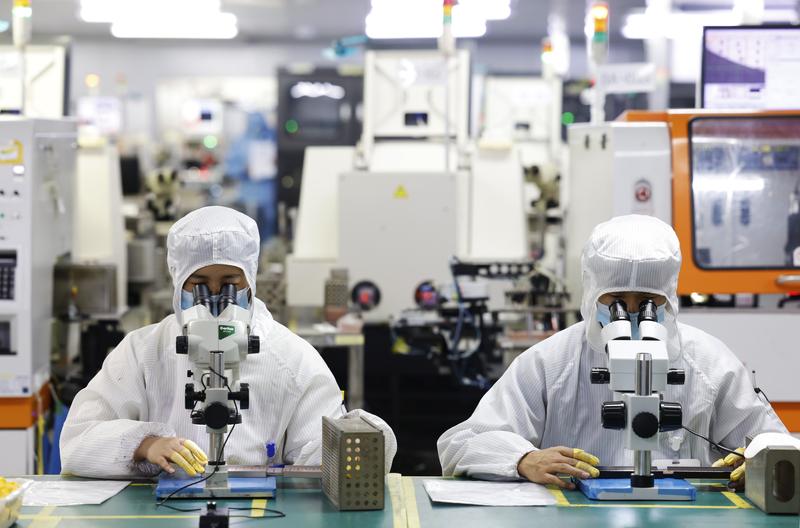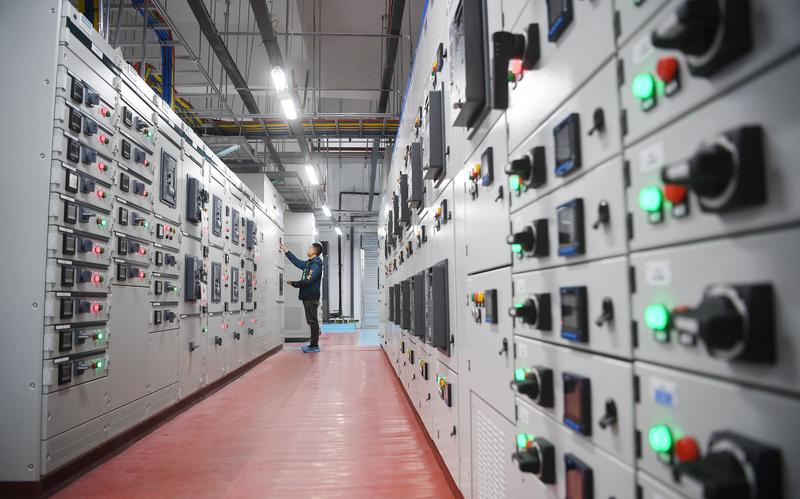Digital field, R&D spends, core tech, monetary and fiscal policies to underpin growth
 Workers produce chips for export at an electronic enterprise in the Sihong Economic Development Zone in Sihong county, Jiangsu province, on Feb 23. China will pursue an innovation-driven development strategy and strengthen the foundation of the real economy amid the COVID-19 pandemic. (XU CHANGLIANG / XINHUA)
Workers produce chips for export at an electronic enterprise in the Sihong Economic Development Zone in Sihong county, Jiangsu province, on Feb 23. China will pursue an innovation-driven development strategy and strengthen the foundation of the real economy amid the COVID-19 pandemic. (XU CHANGLIANG / XINHUA)
As China's two sessions-the annual sittings of the national legislature and the top political advisory body-ended on March 11, they showed the world how in the world's second-largest economy, the intersection of democracy, policymaking and lawmaking contributes to high-quality development, the dream of almost every country these days.
Premier Li Keqiang highlighted the need for China to further implement the innovation-driven development strategy and strengthen the foundation of the real economy at the opening of the fifth session of the 13th National People's Congress earlier this month.
Companies should promote systematic innovation based on original innovations and continuously improve the ability of integrating key technologies into industries.
Liu Qingfeng, a deputy to the 13th National People’s Congress and chairman of iFlytek
Delivering this year's Government Work Report, Li said China will promote scientific and technological innovation for industrial upgrading, eliminate the bottlenecks in supply chains and realize high-quality development through innovation.
The remarks came at a time when the global economy went into a recession amid the COVID-19 pandemic. Changing geopolitical environment and growing trade protectionism added complexities to the economic development of countries globally.
"To achieve innovation, core technology is a key," said Ni Guangnan, an academician at the Chinese Academy of Engineering.
Ni said that over the past year, China has made new breakthroughs in core technologies, including information technology. Domestic central processing unit chips, operating systems and other basic digital technologies have been put into wide use.
"Although the overall market share (of these domestic basic digital technologies) is small, the absolute number of such products has reached 10 million," he said.
"It fully demonstrated that China, as a super large market, has great advantages in driving innovation. The country's scientific and technological innovation capabilities have also been significantly improved."
For instance, in terms of innovation in semiconductors, the government has intensified efforts to develop chips at home so as to reduce reliance on the foreign semiconductor industry. This generated unprecedented levels of enthusiasm and funneled capital from Chinese entrepreneurs into the domestic semiconductor industry, with even carmakers jumping on the auto chip bandwagon.
 An employee checks equipment at the data center of China Unicom in Zhongwei, Ningxia Hui autonomous region, on March 1. China made fresh digital breakthroughs last year. (WANG PENG / XINHUA)
An employee checks equipment at the data center of China Unicom in Zhongwei, Ningxia Hui autonomous region, on March 1. China made fresh digital breakthroughs last year. (WANG PENG / XINHUA)
According to market consultancy Preqin, China surpassed the United States in terms of semiconductor financing last year. Chinese chipmakers, integrated circuit designers and other semiconductor startups received $8.8 billion in funding last year, more than six times the $1.3 billion invested in comparable US companies.
Ding Wenwu, president of China Integrated Circuit Industry Investment Fund Co Ltd, said although investments in the chip design segment increased over the past decade, more efforts are needed in the fields of chip materials, equipment and manufacturing.
"Chip design has a lower technological threshold and quick investment returns. But chip materials, equipment and manufacturing are the areas where China lags developed countries such as the US," Ding said.
More innovations will spring forth in the near future as during the two sessions, the government said the country will "roll out more policy support to encourage businesses to make innovations and focus on tackling bottleneck technologies".
China will work to raise the proportion of weighted pretax deduction of the research and development expenses of small and medium-sized sci-tech enterprises from 75 percent to 100 percent, grant tax breaks to enterprises that invest in basic research, and improve policies on accelerated depreciation of equipment and tools and on preferential corporate income tax for new and high-tech enterprises.
"Our policy of tax and fee reductions is like applying fertilizer and water, and the initiative for mass entrepreneurship and innovation aims to help more market entities take root and grow," said Premier Li at a news conference after the closing of the fifth session of the 13th NPC on March 11.
"When public creativity is leveraged, and the vitality of market entities unleashed, one could well anticipate vibrant economic growth," he said.
 A 5G smart robot and maintenance engineers inspect power supply equipment of the Beijing-Shanghai high-speed railway in Chuzhou, Anhui province, on Jan 17. (SONG WEIXING / FOR CHINA DAILY)
A 5G smart robot and maintenance engineers inspect power supply equipment of the Beijing-Shanghai high-speed railway in Chuzhou, Anhui province, on Jan 17. (SONG WEIXING / FOR CHINA DAILY)
The 2022 draft plan for national economic and social development, released by the National Development and Reform Commission, specified that faster breakthroughs in core technologies such as biomedicines, high-end instruments, green and low carbon energy transformation and basic software will be a priority.
China will also intensify efforts to develop national laboratories, major research projects and innovation centers in Beijing, Shanghai and the Guangdong-Hong Kong-Macao Greater Bay Area, the plan said.
Liu Qingfeng, a deputy to the 13th NPC and chairman of iFlytek, a smart translation company, said such policy support has stimulated the vitality of high-tech companies and inspired more entrepreneurs to pursue innovations.
"Companies should promote systematic innovation based on original innovations and continuously improve the ability of integrating key technologies into industries. More efforts are also expected to be made to guide tech and market talent to join in," Liu said.
This year's Government Work Report also highlighted the efforts of developing digital economy, building more digital information infrastructure, applying 5G technology on a larger scale and advancing digitalization of industries.
Accelerated efforts will also be made for the development of fields like the industrial internet, artificial intelligence, key software and critical hardware, the report said.
As digital technology has become a focus area, Lu Jin, chairman of China National Gold Group Co, said in an interview with China Media Group that the company will beef up technology development and plans to invest about 300 million yuan ($47.24 million) this year to build "digital mines" to promote the digital management and control of mining, so as to further improve mining quality and efficiency.
In one of the companies' gold mines in China's Inner Mongolia autonomous region, unmanned vehicles and drones, rather than human workers, did all transportation and inspection work, which greatly improved mining efficiency and production safety.
"It is the continuous research and development on forefront digital technologies that brought about 1.4 billion yuan to 1.5 billion yuan of profit from this mining area alone last year," Lu said.
According to the China Academy of Information and Communications Technology, a government think tank, China's digital economy reached $5.4 trillion in 2020 in terms of market size, which grew 9.6 percent year-on-year, the fastest worldwide.
"China's digital economy, which is indeed in the fast lane, has become a new driver of the country's economic growth amid the COVID-19 pandemic. It has and will play an important role in driving economic recovery globally," said Gong Ke, former president of the World Federation of Engineering Organizations and executive director of the Chinese Institute of New Generation Artificial Intelligence Development Strategies.
According to China's 14th Five-Year Plan (2021-25), the country will scale up spending on research and development by more than 7 percent annually during the period to drive more technological breakthroughs.
Consulting firm McKinsey &Company said in a report that 7 percent annual growth in R&D spending will set the country on the path to becoming the world's largest spender on R&D.
Peng Wensheng, chief economist and head of research at China International Capital Corp, said: "As demographic dividends gradually decrease, China's economy will rely more on technological innovations in the future. To achieve such technological progress, continuous R&D investment is the key."
However, Peng said China still has a long way to go to bridge the gap with developed countries like the US, both in R&D investment in basic research and R&D investment as a proportion of GDP.
"China's R&D investment must be increased 'substantially' in the coming decades to get rid of what we call the late-mover disadvantage," he said.



